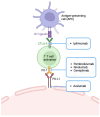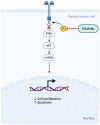Targeted Drug Delivery in Periorbital Non-Melanocytic Skin Malignancies
- PMID: 39451404
- PMCID: PMC11504966
- DOI: 10.3390/bioengineering11101029
Targeted Drug Delivery in Periorbital Non-Melanocytic Skin Malignancies
Abstract
Targeted drug delivery has emerged as a transformative approach in the treatment of periorbital skin malignancies, offering the potential for enhanced efficacy and reduced side effects compared to traditional therapies. This review provides a comprehensive overview of targeted therapies in the context of periorbital malignancies, including basal cell carcinoma, squamous cell carcinoma, sebaceous gland carcinoma, and Merkel cell carcinoma. It explores the mechanisms of action for various targeted therapies, such as monoclonal antibodies, small molecule inhibitors, and immunotherapies, and their applications in treating these malignancies. Additionally, this review addresses the management of ocular and periocular side effects associated with these therapies, emphasizing the importance of a multidisciplinary approach to minimize impact and ensure patient adherence. By integrating current findings and discussing emerging trends, this review aims to highlight the advancements in targeted drug delivery and its potential to improve treatment outcomes and quality of life for patients with periorbital skin malignancies.
Keywords: Merkel cell carcinoma; basocellular carcinoma; periorbital skin malignancies; squamocellular carcinoma; targeted drug delivery systems; targeted drugs.
Conflict of interest statement
The authors declare no conflicts of interest.
Figures




Similar articles
-
Review of recent advances in managing periocular skin malignancies.Front Oncol. 2024 Mar 4;14:1275930. doi: 10.3389/fonc.2024.1275930. eCollection 2024. Front Oncol. 2024. PMID: 38500654 Free PMC article. Review.
-
Periocular cutaneous malignancies: a review of the literature.Dermatol Surg. 2012 Apr;38(4):552-69. doi: 10.1111/j.1524-4725.2012.02367.x. Epub 2012 Mar 8. Dermatol Surg. 2012. PMID: 22404129 Review.
-
Emerging therapeutic options for periorbital and orbital cutaneous basal and squamous cell carcinomas.Orbit. 2023 Apr;42(2):117-123. doi: 10.1080/01676830.2022.2130363. Epub 2022 Oct 10. Orbit. 2023. PMID: 36214105 Review.
-
Targeted therapy and immunotherapy for orbital and periorbital tumors: a major review.Orbit. 2024 Oct;43(5):656-673. doi: 10.1080/01676830.2023.2256848. Epub 2023 Sep 20. Orbit. 2024. PMID: 37728602 Review.
-
Oculoplastic aspects of ocular oncology.Eye (Lond). 2013 Feb;27(2):199-207. doi: 10.1038/eye.2012.243. Epub 2012 Nov 30. Eye (Lond). 2013. PMID: 23196649 Free PMC article. Review.
References
Publication types
Grants and funding
LinkOut - more resources
Full Text Sources

